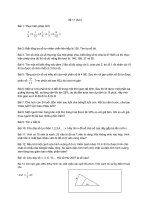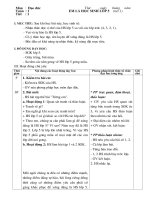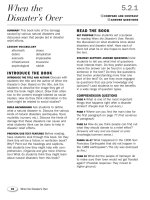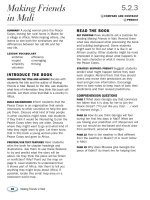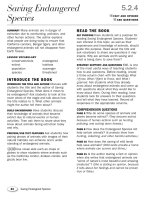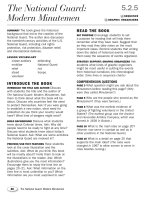- Trang chủ >>
- Mầm non - Tiểu học >>
- Lớp 5
5 2 2 holocaust rescuers TG
Bạn đang xem bản rút gọn của tài liệu. Xem và tải ngay bản đầy đủ của tài liệu tại đây (123.71 KB, 4 trang )
Holocaust
Rescuers
SUMMARY
This informational text describes the
efforts to save Jewish people across Europe
from certain death at the hands of the Nazis
during World War II. The information provided
supports and extends the lesson concept of the
risks people took to help others during
World War II.
LESSON VOCABULARY
agreement
diplomat
refugees
superiors
cable
issue
representatives
visa
INTRODUCE THE BOOK
INTRODUCE THE TITLE AND AUTHOR
Examine with
students the title and the author of Holocaust
Rescuers. Discuss with students what they
expect the book will be about based on its
genre (nonfiction), its cover photographs, and
its title, even if they don’t know the meaning
of the word holocaust.
BUILD BACKGROUND
Have students discuss
what they know about the Holocaust during
World War II. Make sure that students know
that the Holocaust was the Nazis’ plan to
eliminate the Jewish population in Europe and
that six million Jews died during this time.
PREVIEW/USE TEXT FEATURES
Have students
preview the book by skimming the text,
looking at the photos, and reading the
captions. Based on this preview, ask what
students expect to learn about the Holocaust
from reading this book.
36
5.2.2
AUTHOR’S PURPOSE
MONITOR AND FIX UP
READ THE BOOK
SET PURPOSE
Guide students to set their
own purposes for reading the book. Review
students’ predictions about what they will
learn and what they believe is the author’s
purpose.
STRATEGY SUPPORT: MONITOR AND FIX UP
Have students monitor and fix up their
understanding as they read. At the end of
each section, have students write a sentence
summarizing the facts from that section.
COMPREHENSION QUESTIONS
PAGES 5–6
Why were many people unaware
that the Holocaust was happening? (The Nazis
kept their plans secret, and there was no real
proof it was happening.)
PAGES 10–11
What did Britain do to help
Jewish children during World War II? (It
gave visas to thousands of children so they
could live in England.)
PAGES 12–13
What is the author’s purpose in
telling the story of Varian Fry? (to show that
not just governments but individuals and small
organizations tried to help Jews escape the
Holocaust)
PAGES 14–15 Make a generalization about
the villagers in Le Chambon-sur-Lignon. (They
helped many Jews escape the Holocaust but
did not expect praise for their actions.)
PAGES 16–19
Who was Raoul Wallenberg, and
what did he do? (Wallenberg was a Swedish
diplomat who rescued thousands of Jews in
Hungary and moved them to “Swedish houses.”)
Holocaust Rescuers
16917_LRD_TG_036-037 36
12/28/05 1:13:44 PM
REVISIT THE BOOK
READER RESPONSE
1. Possible responses: The Kindertransport
played an important role in saving Jewish
children’s lives. Descriptive words may
include journey, foster, families, sad, safety.
2. He created “Swedish houses” where Jews
could not be attacked. He handed out protective passes to Jews on trains. Answers
will vary as to why these methods might
have been unusual for a diplomat to use.
They may include that what he was doing
was not allowed, or mention that there were
orders to shoot him.
3. Sentences should show understanding of
the definitions.
4. Responses will vary.
EXTEND UNDERSTANDING
Have students reread
the selection title and skim through the
headings used in the text. Then have them
answer each of the following questions: If
the author’s purpose is to inform, how do the
headings help the author provide information
to the reader? (Possible response: They tell
the reader which Holocaust rescuer will be
described in each section so the reader can
keep track of the information.) If the author’s
purpose is to persuade, do the headings help
the author achieve this purpose? Why or why
not? (Possible response: No, most of the
headings only tell the topic of the section, not
the author’s opinion about the topic.)
RESPONSE OPTIONS
WRITING
Provide students with an excerpt from
The Diary of Anne Frank. Have students write
a personal response to Anne’s description of
life in hiding from the Nazis.
SOCIAL STUDIES
CONNECTION
Have students research
other people or groups that
helped Jews survive the Holocaust.
Students can write brief biographies or reports
about these people and organizations.
Skill Work
TEACH/REVIEW VOCABULARY
Write the vocabulary words on the board
and read them aloud. Have students tell
which words are unfamiliar to them. Ask:
Where might you find the meanings of those
words?
Have students use a dictionary or
thesaurus to find as many synonyms as
possible for each vocabulary word. Then
have them put the vocabulary words and
their synonyms on index cards. Have pairs
of students play a game to match the
vocabulary words to their synonyms.
TARGET SKILL AND STRATEGY
AUTHOR’S PURPOSE
Remind students that
an author may write for different purposes—
to inform, to persuade, to entertain, or to
express feelings. Based on their previews,
ask students what they think the author’s
purpose was for writing Holocaust Rescuers.
MONITOR AND FIX UP
Remind students
to monitor, or check, whether or not they
understand what they read. If they find they
do not understand something, one way to
fix up their comprehension is to make a
quick summary of the details they have just
read. Suggest that understanding what they
read will help them determine the author’s
purpose for writing. At the end of each
section, students should ask themselves:
What is the author trying to tell me here?
ADDITIONAL SKILL INSTRUCTION
GENERALIZE
Remind students that when
they generalize they are making a broad
statement that applies to many facts or
examples. Read aloud page 3 and model
how to make a generalization: “One
generalization I can make about this page
is that Hitler convinced many people to hate
Jews, but he failed to convince everyone. I
can make this statement based on the facts
in these paragraphs.”
Holocaust Rescuers
16917_LRD_TG_036-037 37
37
12/28/05 1:13:45 PM
Name
Holocaust Rescuers
Author’s Purpose
• An author’s purpose is the reason an author writes something. Some purposes an author may
have are to persuade, to inform, to entertain, and to express a mood or feeling.
• An author may have more than one purpose in writing a particular selection.
Directions Refer to the selection and answer the questions below.
1. What do you think is the author’s purpose for writing Holocaust Rescuers?
2. Why do you think the author includes the section entitled “Did people know?” (pages 5–7)?
4. How does the last section entitled “Remembering: Yad Vashem” support the author’s purpose?
© Pearson Education 5
3. The author starts page 16 with this sentence: “More than anyone else, Raoul Wallenberg is
remembered for saving Jewish people from the Holocaust.” Why does she write this about
Wallenberg? Use details from the selection to explain your answer.
38
16917_LRD_TG_038_039 1
12/28/05 1:14:22 PM
Holocaust Rescuers
Name
Vocabulary
Directions Use the vocabulary words above to complete the following sentences.
Not all words will be used.
Check the Words You Know
agreement
refugees
cable
representatives
1. Many
became citizens in their new lands.
2. My friend and I are in
in history.
diplomat
superiors
issue
visa
from the Holocaust fled to foreign countries and
that the Holocaust was a terrible time
must be interesting and exciting, since you
3. The work of a
travel and meet people from many other countries.
4. Without a
, it is difficult to enter some foreign countries.
5. When she was growing up, Grandma says, people feared to receive a
because it almost always meant bad news.
Directions For each word below, use a thesaurus to find as many synonyms as you can that relate to
the meaning of the word as it is used in Holocaust Rescuers.
6. issue
7. representatives
© Pearson Education 5
8. superiors
Directions Write two sentences using the words diplomat and refugees.
9.
10.
39
16917_LRD_TG_038_039 39
3/20/06 8:55:10 AM
